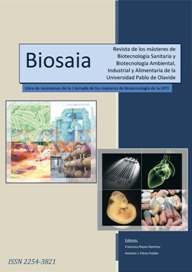Photoswitches Glyconanomaterials: Design Synthesis and Application in Selective Bacterial Cell Agglutination
Palabras clave:
Azobenzene molecules, Cabon-based nanomaterials, Bacterial resistance, Photoswitching, NMR, UV/VisResumen
Motivation: Bacterial resistance represents one of the most important threats facing humanity today, at the level or more serious than climate change, global terrorism or influenza pandemic(1). It is estimated that superbugs, bacteria resistant to our current arsenal of antibiotics, will kill up to 10 million people in 2050 (compared to the current 700,000), if the present situation do not change. A possible solution against this threat is the so-called anti-adhesive therapy, which encompasses the use of inhibitors of bacterial adhesion to epithelial cells, one of the first stages of infection(2). On the other hand, light-responsive photoswitches hybrid nanomaterials are of great importance in a number of fields. In this sense, by introducing photoswitches into bioactive nanomaterials, their biological activity can be switched on or off upon photoisomerization between the implicated isomeric forms. In the present work we report on the design, synthesis and preliminary studies towards the photocontrol selective bacterial cell agglutination of azobenzene-glycoconjugate/carbon nanotube and azobenzene-glycoconjugate /graphene nanocontructs.
Methods: For the synthesis of the sought nanoconstructs a bottom-up approach based on the p-p interaction of pyrene functionalized azobenzene-glycoconjugate and single walled carbon nanotubes (SWCNTs) sidewall, was followed(3,4). Towards this end, an amphiphilic glyconjugate containing FimH adhesin ligand connected to an azobenzene molecule itself connected to large PEG spacer and a pyrene tail, was designed.
Results: Starting from the commercially available mannose pentaacetate, and following a convergent synthetic route with more than 10 steps afforded the desired amphiphile in acceptable yield and high purity. Both the final compound and the synthetic intermediates have been adequately characterized by monodimensional (1H and 13C), bidimensional (COSY, HETCOR) NMR, and mass spectroscopies. 1H NMR and UV/Vis spectroscopy have shown that the final compound and the synthetic intermediates exhibit excellent photochromic properties. Most of these compounds led to a 100% formation of the Z-isomer upon irradiation at 365 nm, whereas the reverse photoisomerization yields quantitatively the E-isomer at the photostationary state using longer wavelength of light.
Conclusions: The excellent photochromic properties of the designed amphiphile, together with our recent finding on nanocarbon-based materials exposing mannose in the agglutination of uropathogenic bacteria(5,6), make us very optimistic on the use of the designed nanohybrids in the photocontrol inhibition of bacterial adhesion to healthy cell.





